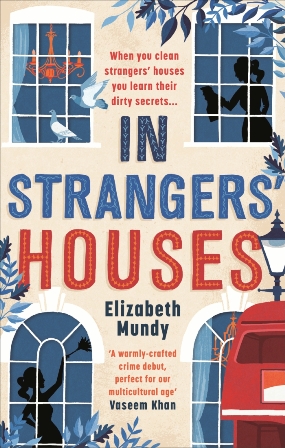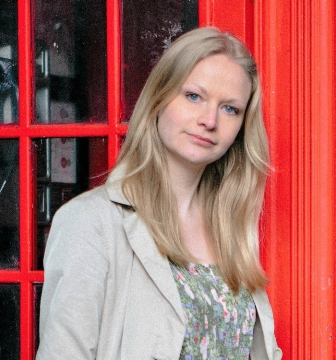Before I even started writing my first murder mystery novel, I knew I wanted a strong woman as my heroine. I was sick of female victims suffering and femmes fatales seducing. I wanted a modern woman solving crimes.

I decided to make my heroine a Hungarian cleaner in London who turns detective when her friend goes missing. She needed to be hard working, direct and brave. But also realistic and rounded. Here’s a few tips that I found helpful as I set about creating her.
Take inspiration from real life
Ironically, Lena, my very modern heroine, was inspired by my great grandmother, Magdaléna. I’ve never even met her; she died long before I was born. But I’ve heard the stories.
In 1912, the year the Titantic sank, she left Hungary and took a boat to America. She was the first of her family to leave her region, let alone the country and the continent. She took her husband and six children with her. By the time they reached New York after eighteen days of terrible sea sickness in steerage she’d had enough.‘Curse you Christopher Columbus,’ she said, shaking her fist at the Statue of Liberty. She wished the country had never been discovered.
Lena, working in London in 2016 has a very different experience to my grandmother in Indiana in 1912. But the will to uproot everything in the hope of discovering a better life – that’s the same.
Be careful though – even if you are lucky enough to know a modern heroine in real life, don’t be tempted to clone her on the page. Matching your fiction too closely to real, recognisable individuals is dangerous territory.
Make her likeable
In Strangers' Houses is the first in a series, and I want Lena to be likeable enough for readers to want to join her in future books. That’s why she doesn’t share another of great grandma Magdaléna’s qualities: meanness. You can’t blame her: Magdaléna had been told the streets in America were paved with gold but she ended up raising her six children in a house with a dirt floor in Indiana. Money was tight, living was tough and Magdaléna began squirreling money whenever she could. She took the wages from all her children (working despite being underage) and according to family legend, buried the money in a jar in the garden. When she suffered from illness in later life she could be seen digging holes outside the house. The jar was never found.
In fact, I made Lena the opposite. She’s generous: not with money, she doesn’t have much of that to give. But with her energy. When she sees a stranger get mugged, she is the only one who leaps to her defence, chasing down the culprit and getting a fist in her face as a result. When her friend (also a cleaner) goes missing, she temporarily takes on all her clients – partly to investigate as she’s suspicious one of them is involved, but also so her friend does not get fired from the agency. Even cleaning her regular clients’ houses she does with gusto: helping people by making things clean gives her great job satisfaction.

Give her weaknesses
You don’t want to create someone too perfect. In Lena’s case, she has a temper. It was something I had to rein in when my writing mentor (the brilliant Philippa Pride) pointed out to me that Lena was slapping someone around the face almost every chapter. Now she sometimes manages to resist the urge.
It’s a hard balance to get right when you have a heroine who is spirited. I wanted to create a character who would stand up for herself, and more importantly, for others. She’s strong and independent, but she knows she can go from zero to a hundred too quickly. Working as a cleaner in rich people’s houses, she has to stop herself getting visibly angry at every inconsiderate thing they do.
Give your character friends
Lena is someone who doesn’t make friends easily, but when she does she’s a friend for life and would do anything for them. Interacting with the people she cares about allows Lena to show her softer side. There’s her childhood friend whose disappearance drives the plot, but then there are others she has picked up along the way. Like Mrs Kingston, a retired journalist who lives alone with her pet rabbit. She’s earned Lena’s friendship by being kind, clever and lonely, and it gives Lena a friend to discuss the case with.
Let them fall in love
How to handle love interests is another quandary for a modern heroine with a feminist bent. Just because Lena is strong and independent doesn’t mean she needs to be single. But deciding how to put your character in a relationship is tricky. She wouldn’t be attracted to someone weak, but she can never be dominated. I chose men for her whose qualities complement, rather than compete with, her own. She’s in a relationship with a Polish taxi driver: comfortable, lazy even, but kind and funny. Without giving too much away, she also had an attraction for a policeman: cerebral, well-mannered and totally in awe of her.
Of course, there’s no one size fits all for how to create a modern heroine. That’s what mine was like – there’s a myriad of other ways to do it. But I think if you take inspiration from real life to use as a springboard, make sure she is likeable, and give her weaknesses, friends and love interests, you’ll have a good start at creating a heroine for our time.
Elizabeth Mundy is the author of IN STRANGERS’ HOUSES, the first in the Lena Szarka mystery series. Find out more at www.elizabethmundy.com.
Comments